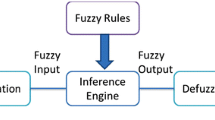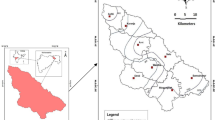Abstract
The groundwater near mines is contaminated heavily as regards acidity, alkalinity, toxicity, heavy mineral, and microbes. During rainy season, the mines are filled with the water which contaminates the groundwater and gradually disperses by percolating through the soil into urban area, making the water unsuitable for use. In addition, fertilizers used for agricultural purpose affect pH and nitrate content of groundwater. Hence, evaluation of WQI of groundwater is extremely important in urban areas close to mines to prepare for make remedial measures. To this end, the present study proposes an efficient methodology such as adaptive network fuzzy inference system (ANFIS) for the prediction of water quality. The parameters used to assess water quality are usually correlated and this makes an assessment unreasonable. Therefore, the parameters are uncorrelated using principal component analysis with varimax rotation. The uncorrelated parameters values are fuzzified to take into account uncertainty and impreciseness during data collection and experimentation. An efficient rule base and optimal distribution of membership function is constructed from the hybrid learning algorithm of ANFIS. The model performed quite satisfactorily with the actual and predicted water quality. The model can also be used for estimating water quality on-line, but the accuracy of the model depends upon the proper training and selection of parameters.
Similar content being viewed by others
References
Adekunle AS (2009) Impact of industrial effluent on quality of well water within Asa dam industrial estate, Horin Nigeria. Nat Sci 7(1):39–42
Almasri ML, Kaluarachchi JJ (2004) Assessment and management of long-term nitrate pollution of groundwater in agriculture-dominated watersheds. J Hydrol 295(1–4):225–245
Ammann AA, Eduard H, Sabine K (2003) Groundwater pollution by roof infiltration evidenced with multi-tracer experiments. Water Res 37(5):1143–1153
Bengraine K, Marhaba TF (2003) Using principal component analysis to monitor spatial and temporal changes in water quality. J Hazard Mater 100:179–195
BIS (1991) Specification for drinking water. 18:10500
Brown RM, Mc Clelland NI, Deininger RA, Ronald GT (1970) A water quality index Do we dare? Water Sew Works 117(10):339–343
Chang NB, Chen HW, Ning SK (2001) Identification of river water quality using the fuzzy synthetic evaluation approach. J Environ Manag 63:293–305
Chau K (2006) A review on integration of artificial intelligence into water quality modeling. Mar Pollut Bull 52(7):726–733
Chaudhari GR, Sohani D, Shrivastava VS (2004) Groundwater Quality Index near industrial area. Indian J Environ Prot 24(1):29–32
Dahiya S, Singh B, Gaur S, Garg VK, Kushwaha HS (2007) Analysis of groundwater quality using fuzzy synthetic evaluation. J Hazard Mater 147(3):938–946
Deb D, Deshpande VN, Das KC (2008) Assessment of water quality around surface coal mines using principal component analysis and fuzzy reasoning techniques. Mine Water Environ 27(3):183–193
Dezfoli KA (2003) Principles of fuzzy theory and its application on water engineering problems. Iran Jihad Press, Tehran
Dinius SH (1972) Social accounting system for evaluating water resource. Water Resour Res 8(5):1159–1177
Hair JF, Black WC, Babin BJ, RE Anderson, Tatham RL (2006) Multivariate data analysis, 1st edn. Prentice Hall, Englewood Cliffs
Horton RK (1965) An index number system for rating water quality. J Water Pollut Control Fed 37(3):300–306
Iscen CF, Emiroglu O, Ilhan S, Arslan N, Yilmaz V, Ahiska S (2008) Application of multivariate statistical techniques in the assessment of surface water quality in Uluabat Lake. Environ Monit Assess 144(1–3):269–276
Jang RJ (1991a) Fuzzy modeling using generalized neural networks and Kalmman filter algorithm. In: Proceedings of ninth national conference on artificial intelligence, pp 762–767
Jang RJ (1991b) Rule extraction using generalized neural networks. In: Proceedings of 4th IFSA world congress, pp 82–86
Jang RJ (1993) ANFIS: Adaptive-network-based fuzzy inference system. IEEE Trans Syst Man Cybern 23(3):665–685
Jang RJ (1994) Structure determination in fuzzy modeling: A fuzzy CART approach. In: Proceedings of IEEE international conference on fuzzy systems, Orlando, Florida
Jang RJ, Gulley N (1996) Fuzzy logic toolbx: Reference manual. The Math works Inc, Natick
Jang JSR, Sun CT, Mizutani E (1997) Neuro-fuzzy and soft computing, a computational approach to learning and machine intelligence, 1st edn. Prentice Hall, Englewood Cliffs
Jha AN, Verma PK (2000) Physico-chemical properties of drinking water in town area of Godda district under Santal Pargana (Bihar), India. Pollut Res 19(2):245–247
Jinwal A, Dixit S (2008) Pre and post monsoon variation in physico-chemical characteristic in groundwater quality in Bhopal, India. Asian J Exp Sci 22(3):311–316
Julien B (1994) Water quality management with imprecise information. Eur J Oper Res 76:15–27
Kandel A (1988) Fuzzy expert systems. Addison-Wesley, Reading
Kandel A (1992) Fuzzy expert systems. CRC Press, Boca Raton
Karnchanawong S, Ikeguchi SKT (1993) Monitoring and evaluation of shallow well water quality near a waste disposal site. Environ Int 19(6):579–587
Klassen MS, Pao YH (1988) Characteristics of the functional link net: A higher order delta rule net. In IEEE proceedings of the international conference on neural networks, San Diego
Lind CJ, Carol L, Creasey CA (1998) In-situ alteration of minerals by acidic groundwater resulting from mining activities: Preliminary evaluation of methods. J Geochem Explor 64(1–3):293–305
Lohani BN, Todino G (1984) Water quality index for Chao Phrayariver. J Environ Eng 110(6):1163–1176
Maticie B (1999) The impact of agriculture on groundwater quality in Slovenia: Standards and strategy. Agric Water Manag 40(2–3):235–247
Nagarajan P, Priya GK (1999) Groundwater quality deterioration in Tiruchirapalli, Tamilnadu. J Ecotoxicol Environ Monit 9(2):155–159
Ocampo-Duque W, Ferre-Huguet N, Domingo JL, Schuhmacher M (2006) Assessing water quality in rivers with fuzzy inference systems: A case study. Environ Int 32:733–742
Pao YH (1989) Adaptive pattern recognition and neural network, 1st edn. Addison Wesley, Reading
Parinet B, Lhote A, Legube B (2004) Principal component analysis: An appropriate tool for water quality evaluation and management-application to a tropical lake system. Ecol Model 178:295–311
Pedrycz W (1989) Fuzzy control and fuzzy systems. Wiley, New York
Rizwan R, Jain MK, Singh G (2009) Impact of mining activities on surface water quality in Angul-Talcher region of Orissa, India. Min Eng J 10(11):22–28
Rumelhart DE, Hinton GE, William DE (1986) Learning internal representations by error propagation. In: Parallel distributed processing: Explorations in the microstructure of cognition. MIT Press, Cambridge, pp 1–8, 318–362
Sabal D, Khan TI (2008) Fluoride contamination status of groundwater in Phulera Tehsil of Jaipur district, Rajasthan. J Environ Biol 29:871–876
Shaji C, Nimi H, Bindu L (2009) Water quality assessment of open wells in and around Chavara industrial area, Quilon, Kerala. J Environ Biol 30(5):701–704
Shamruck M, Corapcioglu MY, Fayek AA, Hasson A (2001) Modeling the effect of chemical fertilizers on groundwater quality in the Nile Valley aquifer, Egypt. Groundwater 39(1):59–67
Sharma RK, Agarwal M (2005) Biological effects of heavy metals. J Environ Biol 26:301–313
Shrestha S, Kazama F (2007) Assessment of surface water quality using multivariate statistical techniques: A case study of the Fujiriver basin, Japan. Environ Model Softw 22:464–475
Silvert W (2000) Fuzzy indices of environmental conditions. Ecol Model 130:111–119
Singh B, Dahiya S, Jain S, Garg VK, Kushwaha HS (2008) Use of fuzzy synthetic evaluation for assessment of groundwater quality for drinking usage: A case study of Southern Haryana, India. Environ Geol 54:249–255
Singh KP, Parwana HK (1999) Groundwater pollution due to industrial wastewater in Punjab state and strategies for its control. Indian J Environ Prot 19(4):241–244
Srinivas C, Shankar PR, Venkateshwar C, Rao MSS, Reddy RR (2000) Studies on groundwater quality of Hyderabad. Pollut Res 19(2):285–289
Sudhakar MR, Mamatha P (2004) Water quality in sustainable water management. Curr Sci 87:942–947
Sugeno M (1985) Industrial applications of fuzzy control. Amsterdam, Elsevier
Sugeno M, Kang GT (1988) Structure identification of fuzzy model. Fuzzy Sets Syst 28:15–33
Takagi T, Sugeno M (1985) Fuzzy identification of systems and its applications to modeling and control. IEEE Trans Syst Man Cybern 15:116–132
Tyagi P, Budhi D, Sawhney R (2003) A correlation among physico-chemical parameters of groundwater in and around Pithampur industrial area. Indian J Environ Prot 23(11):1276–1282
Ubala MB, Farooqui M, Arif PM, Zaheer A, Dhule DG (2001) Regression analysis of groundwater quality data of Chikalthana industrial area, Aurangabad (Maharashtra). Orient J Chem 17(2):347–348
Werbos P (1974) Beyond regression: New tools for prediction and analysis in the behavioral sciences. Dissertation. Harvard University
WHO (2006) Guidelines for drinking water quality first addendum to 3rd Ed. (I) recommendations, Geneva, Switzerland
Zhang WL, Tian ZX, Zhang N, Li XQ (1996) Nitrate pollution of groundwater in northern China. Agric Ecosyst Environ 59(3):223–231
Zhou J, Su G, Jiang C, Deng Y, Li C (2007) A face and finger print identity authentication system based on multi-route detection. Neurocomputing 70:922–931
Author information
Authors and Affiliations
Corresponding author
Rights and permissions
About this article
Cite this article
Sahu, M., Mahapatra, S.S., Sahu, H.B. et al. Prediction of Water Quality Index Using Neuro Fuzzy Inference System. Water Qual Expo Health 3, 175–191 (2011). https://doi.org/10.1007/s12403-011-0054-7
Received:
Revised:
Accepted:
Published:
Issue Date:
DOI: https://doi.org/10.1007/s12403-011-0054-7




